Thomas May's Blog, page 8
January 1, 2025
Happy New Year!
December 24, 2024
The Calidore Quartet on Their Beethoven Cycle
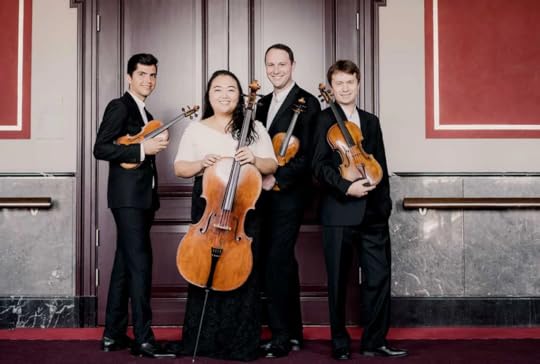 Calidore String Quartet: Ryan Meehan, left, Estelle Choi, Jeffrey Myers, and Jeremy Berry, Photo: Marco Borggreve
Calidore String Quartet: Ryan Meehan, left, Estelle Choi, Jeffrey Myers, and Jeremy Berry, Photo: Marco BorggreveFor Strings magazine’s first edition of 2025, I spoke with Calidore Quartet violinist Ryan Meehan about their recording of the complete Beethoven quartets:
To accompany its ongoing release of the complete Beethoven cycle, the Calidore String Quartet has chosen Mark Rothko–like images as cover art: floating fields of color that seem suspended in time. “We’re all huge fans of Rothko’s work,” says violinist Ryan Meehan. “These colors are so bold and sometimes polarizing. Each color creates such a clear feeling on its own, but then as a collective, they also fill the viewer with an intense inner feeling. That’s very similar to Beethoven in that sections can be so contrasting from one to another, but the combination is an experience that you don’t forget.”
continue
December 12, 2024
Not Just Another “Messiah”: Harmonia’s Seattle Handel Tradition
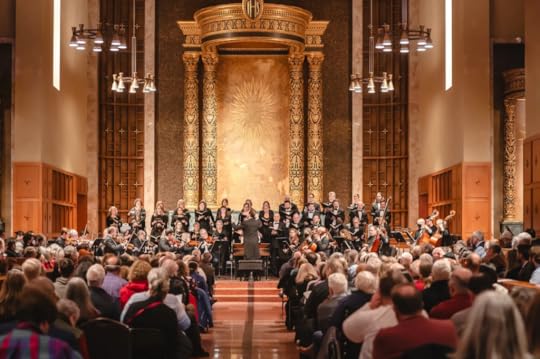 Harmonia Orchestra & Chorus performs Messiah in 2023. Its Messiah performances this year are Dec. 14 and 15. (Carlin Ma)
Harmonia Orchestra & Chorus performs Messiah in 2023. Its Messiah performances this year are Dec. 14 and 15. (Carlin Ma)My latest for The Seattle Times:
Like Starbucks rolling out its festively colored holiday cups, performances of “Messiah” make an inevitable appearance each December. For many, it’s as much a part of the season as twinkling lights and the scent of pine….
December 11, 2024
OPrak, New York’s First Disability-Affirmative Opera Company
From the OPrak press release:
New York’s first disability-affirmative opera company OperaPraktikos.org (OPrak) presents There Will Be Cake – a matinee mono-opera concert series on Thursday-Saturday, 12-14 December 2024, at 1:30 p.m., at downtown Manhattan’s Asylum NYC.
Opera Praktikos (OPrak), established in 2021, proudly stands as New York City’s pioneering disability-affirmative opera company. Its mission is to make opera an inclusive and accessible art form for audiences and artists alike by crafting exceptional opera productions that transcend conventional barriers related to class, economic status, and physical challenges.
Through deliberate reinterpretations of classical operas and the commissioning of new works, it aims to ensure that artists and audience members can readily identify with the stories and lived experiences of People with Disabilities being portrayed on the stage. OPrak is dedicated to breaking down stereotypes about disability and fostering an inclusive and accessible opera community in the heart of New York City.
With performances by abled and disabled artists, this site-specific musical drama centers around food and its visceral memories and emotions. Bon Appetit! shares Julia Child’s words of wisdom in a light-hearted, charming masterclass in comedic character singing followed by the world premiere of Fluffernutter, an opera inspired by the delicious Fluffernutter sandwich.
“Two slices of Americana to perk up any jaded New Yorker’s palette: that ineffable cook Julia Child makes a French chocolate cake; and a tasty New England staple reminds us that aging is hard,” explains Greg Moomjy, musicologist and co-founder/artistic director of OPrak. A man who has Cerebral Palsy and is a wheelchair user, Moomjy invites New Yorkers with and without disabilities to unite over their shared interest in live music and dessert. When assembling this program, we wanted to give audiences small samplings of comic opera performed by top-notch singers at an accessible venue. And, yes, we will also serve cake!”
The program begins with Lee Hoiby’s Bon Appetit! (1989), adapted from two episodes of Julia Child’s well-loved cooking show, The French Chef. With approval and input from Child herself, a friend of the composer, the libretto narrates Child’s cooking of a chocolate cake with clever lines such as “Choc’late is much more complicated than any of us suspect.” Reflecting the television show’s format, the opera is written for a single singer, performed here by Hailey McAvoy, a “gorgeous-voiced (Broadway World)” mezzo-soprano with Cerebral Palsy. Another “sweet” mono-opera is the world premiere of Fluffernutter (2024) inspired by the New England tasty treat. Composer Spicer Carr is a queer, autistic writer who was commissioned by OPrak to write Fluffernutter with libretto by OPrak’s co-founder Marianna Mott Newirth. Fluffernutter evokes the trials of adulting and the power of nostalgia all thanks to the classic peanut butter-marshmallow crème sandwich.
Program + Ticketing Information:
Thursday-Saturday, December 12-14, 2024, at 1:30 p.m.
Asylum NYC, 123 East 24th Street, New York City, Subway: 4/6 to 23rd Street.
Tickets: $10-$35 (ages 16+ only). Livestream (Saturday only) $10-$35. To reserve, visit AsylumTix.com or call 212.203.5435.
Cast + Crew:
Hailey McAvoy – mezzo-soprano
Shanley Horvitz – zwischenfach
Calvin Hitchcock – piano + music director
Gwynn MacDonald – stage director
Program:
Bon Appetit! composed by Lee Hoiby (1926-2011) with text by Julia Child adapted by
Mark Shulgasser
Fluffernutter (2024) **world premiere** composed by Spicer Carr with libretto by Marianna Mott Newirth and piano arr. by Patrick Tice-Carroll
December 3, 2024
Trusting Yourself: Jessica Meyer on Her Career as a Violist-Composer
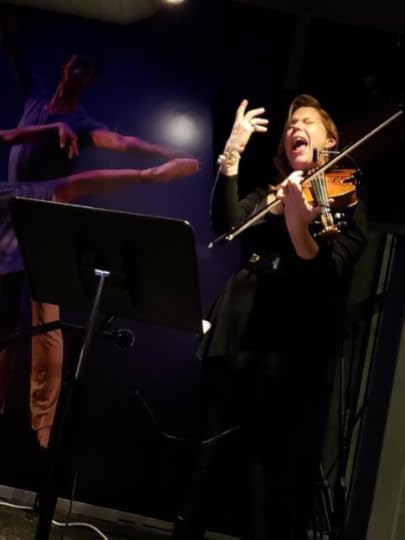 Jessica Meyer; photo (c) Ben Fingland
Jessica Meyer; photo (c) Ben FinglandI got to speak with the incredible violist-composer Jessica Meyer for The Strad. Her “Spirits and Sinew” is part of Hub New Music‘s 10th-anniversary program later this week at the Kaufman Music Center:
The award-winning composer and violist Jessica Meyer is an unclassifiable phenomenon even in today’s genre-defying contemporary music sphere. Meyer has been carving a unique space through her extraordinary blend of creativity, charisma, technical mastery, educational work and innovation, all in service of an urge to share ideas and build musical communities.
continue
November 25, 2024
Requiems and Riddles: Seattle Symphony Muses on the Ultimate Questions
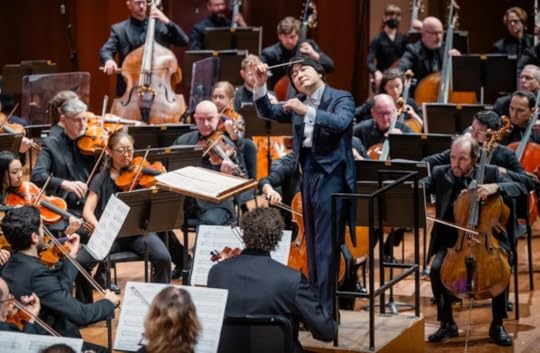 Kazuki Yamada conducts the Seattle Symphony; image (c) Brandon Patoc
Kazuki Yamada conducts the Seattle Symphony; image (c) Brandon PatocSome thoughts on the Seattle Symphony’s recent program with Kazuki Yamada:
The state of the world this November feels especially conducive to mourning. Before presenting one of the best-loved Requiems in the canon, visiting conductor Kazuki Yamada opened his Seattle Symphony program with a much less frequently encountered work of grieving by his great compatriot Tōru Takemitsu. Requiem for string orchestra signaled the young Japanese composer’s international breakthrough after Stravinsky heard it and pronounced the composition a masterpiece. ..
continue
November 22, 2024
Sounds of Change: Ayane Kozasa and Paul Wiancko on the New Kronos Quartet Formation
 Kronos Quartet; image by Danica Taylor
Kronos Quartet; image by Danica TaylorA new interview for The Strad: I spoke with Ayane Kozasa and Paul Wiancko of the Kronos Quartet about the dramatic change in the ensemble’s lineup that began with the current season:
Having celebrated its 50th anniverary last season, the Kronos Quartet has already begun its latest chapter with a dramatic change in the ensemble’s makeup. Longtime members John Sherba (violin) and Hank Dutt (viola) retired at the end of June, leaving violinist David Harrington, who founded Kronos, as the sole remaining member from the early years. Dutt had been part of Kronos since 1977, while Sherba joined them in 1978. Cellist and composer Paul Wiancko began his relationship with the quartet in 2019 and took the place of Sunny Yang in February 2023. Violinist David Harrington, who founded Kronos, is the only member who now remains. ..
November 16, 2024
Legends of Brazil: A Musical Celebration of 200 Years
 André Mehmari, Angel Gil-Ordóñez, and the PostClassical Ensemble
André Mehmari, Angel Gil-Ordóñez, and the PostClassical EnsembleThe year 2024 marks the 200th anniversary of diplomatic relations between the United States and Brazil. To celebrate the bicentennial, Postclassical Ensemble (PCE) will showcase two centuries of music from South America on 19 and 20 November at the Kennedy Center
The program ranges from the earliest known works by composers native to Brazil to a world premiere commission by pianist-composer André Mehmari. Guest curator Flávio Chamis and guest artists Lucas Ashby (percussion), Tatjana Mead Chamis (viola), and Elin Melgarejo (vocalist) join Mehmari and artistic director and condutor Ángel Gil-Ordóñez.
PROGRAM:
Legends of Brazil: A Musical Celebration for 200 Years of Friendship
Tue. Nov. 19, 2024 7:30p.m
Wed. Nov. 20, 2024 7:30p.m
Terrace Theater | The Kennedy Center | 2700 F St NW, Washington, DC
Presented without intermission
Flávio Chamis, guest curator
Lucas Ashby, percussion
Tatjana Mead Chamis, viola
André Mehmari, piano and composer
Elin Melgarejo, vocalist
PostClassical Ensemble conducted by Angel Gil-Ordóñez
Zequinha de Abreu arr. Jamberê Cerqueira: Tico-Tico no Fubá
Padre José Maurício Nunes Garcia: Zemira
André Mehmari: Sonata for Viola
Francisco Mignone: Selection from Tres Valsas Brasileiras
Francisco Mignone: Saci and Caapora from Quadros Amazônicos
Brazilian popular songs arranged for voice and chamber orchestra: Odeón, One Note Samba, Labrinto, Samba em Preludio
Heitor Villa-Lobos: Preludio from Bachiana Brasileiras no. 4
André Mehmari: Rag Chorado. A Celebratory Humoreske (world premiere work for piano and orchestra)
Complete list of events with program notes here.
November 5, 2024
Vox Luminis Makes PNW Debut with Monteverdi
Lionel Meunier and his vocal and period instrument ensemble Vox Luminis make their Pacific Northwest debut this weel with a program of sacred music by Claudio Monteverdi. Presented by Cappella Romana, there will be performances in Portland on 6 November and in Seattle on 7 November, both at 7.30pm (St. Mary’s Cathedral in Portland and St. Demetrios Greek Orthodox Church in Seattle); tickets here.
French conductor and baritone Lionel Meunier counts among the most influential figures in today’s historical performance and choral scenes. He founded Vox Luminis (“Voice of light”) in Belgium in 2004, having studied at the Institut Supérieur de Musique et Pédagogie in Namur.
Vox Luminis comprises a core ensemble of vocal soloists specializing in English, Italian, and German repertoire from the 17th and early-18th centuries; depending on the repertoire, they are supplemented with solo instruments, an extensive continuo, or a complete orchestra.
Artist in residence at Concertgebouw Brugge, Vox Luminis has earned international acclaim for its signature sound, with each voice emerging in a solo light while being able to fuse with the others “into one luminous fabric of sound.” The ensemble performs some 70 concerts a year and boasts an award-winning discography.
Meunier has put together a program of sacred music by Monteverdi, mostly from his later collection Selva morale e spirituale (“The Virtuous and Spiritual Forest”), which was published in 1640-41 in Venice. They will also present a couple of motets and the instrumental and vocal versions of the motet O bone Jesu o piissime Jesu (“O good Jesus, have mercy on us”).
PROGRAM:
Gloria (SV 258) from Selva morale e spirituale
Dixit Dominus II (SV 264) from Selva morale e spirituale
Beatus vir I (SV 268) from Selva morale e spirituale
O bone Jesu o piissime Jesu (SV 313) (instrumental version)
Adoramus te Christe (SV 289) from Libro primo de motetti, Giulio Bianchi
Cruxifixus (SV 259) from Selva morale e spirituale
Laetaniae della Beata Vergine (SV 204) from Libro secondo de motetti, Giulio Bianchi
O bone Jesu o piissime Jesu (SV 313) (vocal version)
Magnificat I (SV 281) from Selva morale e spirituale
David Lee’s program notes:
Claudio Monteverdi was born in Cremona, the son of a surgeon and apothecary. Although there is no record of him being a member of the city’s cathedral choir, the young Monteverdi received his first composition lessons from its maestro di cappella Marc’Antonio Ingegneri, whose teachings he acknowledged in his first publications.
Monteverdi was clearly a precocious talent. His first publication, the three-voiced Sacrae cantiunculae (1582), was printed when he was just 15 years old. After attempts to find employment in Verona and Milan, he was eventually appointed as a viol player at the court of Vincenzo I Gonzaga, Duke of Mantua. It was in Mantua that he first began to experiment with the contemporary forms of liturgical music and develop a novel approach that united elements of the musical past and present, while offering glimpses of the future. This balance between tradition and innovation was epitomised in his much-loved Vespro della Beata Vergine of 1610. His compositional achievements undoubtedly helped him in 1613, when he advanced to the prestigious post of maestro di cappella at Venice’s Basilica di San Marco, where he would remain until the end of his career.
The majority of the repertoire contained within this programme is drawn from three publications: the Selva morale e spirituale(‘Moral and Spiritual Forest’), published in 1640, and Giulio Bianchi’s two books of motets, both of which were published in 1620. The Selva morale e spirituale was a retrospective anthology that drew together some of his most innovative and successful music from his time in Mantua alongside his more recent Venetian work. It includes a mass, several psalm and Marian hymn settings, as well as two separate Magnificats. Bianchi was a cornettist and composer, who was also born in Cremona and led the wind band at Mantua alongside Monteverdi.
The seven-voiced setting of the Gloria is thought to have originally been part of a large-scale mass written by Monteverdi in 1631 to commemorate the end of the Italian Plague of 1629-31 (also known as the Great Plague of Milan). The plague brought great devastation to northern Italy and is thought to have killed up to 50,000 people in Venice alone. Monteverdi divides the Gloria into five distinct sections, closely following the sense of the text. Over the course of the piece, individual voices and pairs of voices emerge from the main texture with flashes of rapid coloratura, to participate in a compelling musical dialogue with the violins.
Dixit Dominus is the first psalm of the evening office of Vespers on Sundays and feast days. As part of the San Marco liturgy, Vespers services on special occasions saw the uncovering of the Pala d’Oro, the exquisite gold high altar at the far east end of the church. To accompany this, sixteenth-century Venetian composers normally produced lavish eight-voice, double-choir settings of the Dixit Dominus. While this second setting by Monteverdi is scored for eight voices, he does not stick to a rigid division between two ensembles. Instead, he uses the forces in a series of different combinations to depict the psalm’s lucid imagery — for example, using the full ensemble to terrifying effect in the stile concitato (‘agitated style’) section at the words Confregit in die irae suae reges (‘The Lord shall strike through kings in the day of his wrath’), but then suddenly paring back, in complete contrast, to a pair of soprano voices for the beginning of the following verse.
One of Monteverdi’s best-known later sacred works, Beatus vir (his first of two settings of Psalm 111) was actually based on a secular canzonetta Chiome d’oro, which was included in his Seventh Book of Madrigals (1619). In Beatus vir, Monteverdi borrows the charm and naïveté of his earlier work, originally addressed to the beauty of a lover’s physical features, to convey the blissful assurance of the faithful man that fears God and obeys his commandments.
Adoramus te, Christe was included in Bianchi’s first book and is a simple but heartrending setting of a text from the Hours of the Cross in devotional Books of Hours. Its opening statement, ‘We adore you, O Christ’, is tinged with bittersweetness, effected by Monteverdi’s unconventional use of dissonances, but the closing statements of Miserere nobis (‘Have mercy on us’) bring comfort and solace in the ending.
In addition to the simple four-part mass setting published in the Selva morale, Monteverdi also includedsome more modern alternative settings that could be substituted for sections of the mass. This short Crucifixus setting is one such alternative. It is cast in a much more modern style, with its descending chromatic line giving it a distinctly different character to the ordinary of the mass, which remained very consciously within the parameters of the stile antico.
There was a conspicuous increase in expressions of Marian devotion in Venice from 1571, after the city’s victory over the Turkish navy at the Battle of Lepanto, with Pope Pius V attributing the victory to the intervention of the Virgin Mary. As part of this, musical settings of the Litany became popular. Monteverdi’s setting of the Litany of Loreto, the Litaniae della Beata Vergine, was printed in Bianchi’s second book. Between the opening Kyrie eleison and the closing Agnus Dei, the Litany consists of a sequence of invocations addressed to the Trinity and then to Mary, as mother, virgin, saint and queen. The music is relatively simple and it is likely the piece was intended to be sung in procession.
O bone Jesu was actually first printed outside Italy, in a collection entitled Promptuarii musici issued by the German composer Johannes Donfrid in Strasbourg in 1622. A simple setting for two sopranos and continuo of a devotional hymn text, it is an example of the so-called ‘echo motet’, whereby the first voice sings a phrase that is immediately repeated by the second voice, before the pair join together to elaborate and extend the melodic materials. Growing out of a fairly sparse opening, the piece builds cumulatively in intensity, culminating in the final invocation, Salva me (‘save me’).
Following the five psalms at Vespers, the Magnificat featured as the centrepiece of the liturgy, being sung as the altar was censed. This eight-voice setting is the first of two contained within the Selva morale e spirituale.Breaking the text down into a series of standalone sections, Monteverdi explores its vivid imagery in a number of fresh ways. The stile concitato is introduced once again with the words Fecit potentiam in brachio suo (‘He hath showed strength with his arm’). In juxtaposing these modern forms of expression with elements of the musical past, in the shape of short fragments of plainsong and imitative polyphony, Monteverdi demonstrates his unique ability to make the unfamiliar seem somehow familiar. These truly immersive soundworlds must have been utterly entrancing to seventeenth-century ears — but they remain no less captivating to contemporary audiences.
Program notes by David Lee
October 31, 2024
New York Philharmonic Honors Pierre Boulez
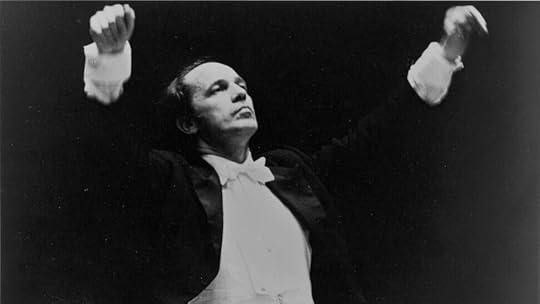 Pierre Boulez NY Phil Shelby White & Leon Levy Digital Archives
Pierre Boulez NY Phil Shelby White & Leon Levy Digital ArchivesMy Playbill feature on the NY Philharmonic’s homage to its former music director as the music world marks the 100th anniversary of the birth of Pierre Boulez in 2025:
In March 1969 Pierre Boulez — then 43 — made his New York Philharmonic debut conducting a month of concerts. The engagement, which included a much-discussed performance of Stravinsky’s The Rite of Spring, quickly resolved the question of who would succeed Leonard Bernstein as Music Director. A mere three months later came the announcement officially appointing Boulez to the post…
continue
Thomas May's Blog




